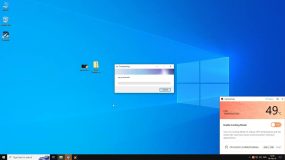Automatic Repair is a built-in Windows 10/11 feature that helps resolve boot issues by automatically detecting and fixing problems when a device fails to start correctly twice in a row. It serves as a helpful tool for restoring Windows functionality.
While this is a feature for the convenience of users, some have reported that, after the recent Windows updates, there has been an issue with error messages. Many find themselves stuck in a “Preparing Automatic Repair” boot loop-the system keeps attempting repairs but then cannot fix whatever problem it believes exists. And, for some, no matter what they try, they cannot break out of the cycle.
If you’re experiencing the “Preparing Automatic Repairs” loop on Windows 10/11, this guide on Outbyte will help you understand what causes the issue and provide practical solutions to restore your system.
What Causes “Preparing Automatic Repairs” Loop?
The “Preparing Automatic Repair” loop refers to when Windows tries to diagnose the problem bothering its normal startup but manages to get itself stuck in that endless cycle. These can be due to corrupted system files, broken and incompatible drivers, bad sectors on the hard drive, malware infection, and failures in Windows updates. Each of these prevents Windows from completing the repair process successfully, hence the infinite resultant loop.

Read about other common Windows errors:
UNEXPECTED KERNEL MODE TRAP Error
WHEA_UNCORRECTABLE_ERROR error
What to Do About “Preparing Automatic Repairs” Loop on Windows 10/11
Fix #1: Enable the No-Execute Memory Protect Feature
Enabling the XD-bit or No-Execute Memory Protect feature can help stop the boot loop error. Since this feature is usually disabled by default, you need to enable it manually:
- Restart your computer.
- While it’s booting, press the key to enter the BIOS settings. This key is typically displayed during startup or mentioned in your user manual.
- In the BIOS menu, locate the XD-bit or No-Execute Memory Protect option.
- Enable it and select Save to apply the changes.
- Restart your computer to see if it boots properly.
Fix #2: Perform a System Restore
If the loop started following a recent update or installation of some software, go back using System Restore to an earlier point:
- Start Advanced Startup Options and, under Advanced Options, click System Restore.
- Select a restore point prior to when this problem started showing up.
Fix #3: Reinstall Windows 10/11
If none of the other options work, the issue could be your Windows installation itself. Reinstalling Windows 10 or 11 will fix the problem.
- Start the Setting application.
- Head to Update and Security > Recovery.
- Under Reset This PC, click Get Started.
- Click Remove everything to clear all settings and files-just make sure you’ve backed everything up.
- Let Windows reinstall and hope the boot loop error is fixed.
Fix #4: Check Your Hardware Components
If reinstalling Windows doesn’t fix the issue, the problem might be hardware-related, like a failing HDD or SSD. Inspect your hard drive or SSD for errors to rule out hardware failure.
Fix #5: Run Startup Repair
If startup still fails, use Startup Repair:
- Go to Advanced Options > Troubleshoot > Advanced Options.
- Select Startup Repair and let Windows fix any issues.
- Restart your PC and see if the problem is resolved.
Fix #6: Use Command Prompt
Command Prompt can help fix the boot loop:
- Open Advanced Options > Troubleshoot > Advanced Options > Command Prompt.
- Enter your primary drive letter and press Enter.
- Type these commands one by one, pressing Enter after each:
md backup
copy *.* backup
cd regback
copy *.*Type A to overwrite files when prompted. Close Command Prompt and select Continue. Check if the error is fixed.
Fix #7: Update Your Drivers
Outdated drivers might cause the “Preparing Automatic Repairs” error. To update them:
- Boot into Safe Mode with Networking:
- Go to Advanced Options > Troubleshoot > Startup Settings and press F5.
- Open Device Manager by pressing Windows + R, typing
devmgmt.msc, and hitting Enter. - Look for Display Adapters, right-click your driver, and select Update Driver.
- Choose Search Automatically for Updated Driver Software and let Windows install any updates.
If that sounds a bit complicated, then use a Outbyte Driver Updater utility and take the easier route.
In our Driver library you can find the most suitable System Drivers for your OS and a short guide on how to install it.
Fix #8: Repair Corrupted Data
If the issue is with the damaged hard drive: Remove the hard disk and connect it to another computer. Boot from the disk and select the Repair HDD option, if available. Reinstall the disk and check whether the problem is solved.
Fix #9: Repair the Boot Configuration Data (BCD)
Corrupted boot files can cause the loop. In order to repair them:
Boot into the recovery environment. Open Command Prompt and execute the following commands one by one:
bootrec /fixmbr
bootrec /fixboot
bootrec /scanos
bootrec /rebuildbcdRestart your system to see if the problem is resolved.
Fix #10: Restore the Windows Registry
Restoring the Windows Registry may resolve this problem. Here is how:
- In the Advanced Boot Options window, select Troubleshooting > Advanced options > Command Prompt.
- Type the command
cd C:\windows\system32\logfiles\srt\and press Enter. Change the drive letter if appropriate. - Open Notepad by typing
txtand pressing Enter. - Press CTRL + O, select All Files, and navigate to
C:\windows\system32. - Open Command Prompt as Administrator.
- Rename registry files by typing these commands (press Enter after each):
rename DEFAULT DEFAULT.bak
rename SAM SAM.bak
rename SECURITY SECURITY.bak
rename SOFTWARE SOFTWARE.bak
rename SYSTEM SYSTEM.bakRestore backups with this command: copy c:\windows\system32\config\RegBack c:\windows\system32\config.
Restart your PC to see if the problem is resolved.
FAQs
What does “Preparing Automatic Repair” mean?
It’s a Windows feature that diagnoses and attempts to fix startup issues.
Can I fix the loop without losing my data?
Yes, most methods, like System Restore and disk checks, preserve your files. Choose to keep your data if resetting Windows.
How do I access Safe Mode from the loop?
Restart your PC and press F8 or Shift + F8 during startup to access Safe Mode.
Why does this loop keep on repeating itself even after fixing?
Recurring problems can be indicative of hardware issues, such as a failing hard drive. Run diagnostic tests on your hardware.
Is malware a possible cause?
Yes, malware might corrupt system files further and lead to the loop. Scanning the PC with reliable antivirus, such as Outbyte AVarmor, can help prevent it.





